Resent results:
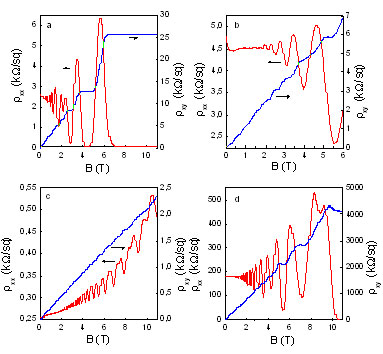 · The Shubnikov-de Haas (ShdH) oscillations in conductivity of a two-dimensional hole gas in quantum wells Si1-xGex with different compositions (x=0.13; 0.36; 0.95; 0.98) were investigated. It was shown that the factors which affect deviation of effective mass can be: a) influence of the spin splitting on amplitude of SdH
oscillations maxima; b) extra broadening of the Landau levels attributed to
existence of inhomogeneous distribution of the carrier concentration; c) the
influence of the concurrent existence of short and long-range scattering
potentials; d) the population of second energy level in the quantum well. The
work takes into account these factors and shows the values of the effective mass
of charge carriers in quantum wells Si1-xGex [1,
2].
· The Shubnikov-de Haas (ShdH) oscillations in conductivity of a two-dimensional hole gas in quantum wells Si1-xGex with different compositions (x=0.13; 0.36; 0.95; 0.98) were investigated. It was shown that the factors which affect deviation of effective mass can be: a) influence of the spin splitting on amplitude of SdH
oscillations maxima; b) extra broadening of the Landau levels attributed to
existence of inhomogeneous distribution of the carrier concentration; c) the
influence of the concurrent existence of short and long-range scattering
potentials; d) the population of second energy level in the quantum well. The
work takes into account these factors and shows the values of the effective mass
of charge carriers in quantum wells Si1-xGex [1,
2].
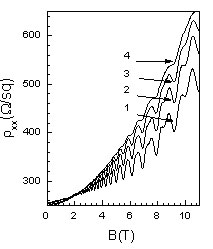 · The Shubnikov-de Haas oscillations of conductivity in a two-dimensional hole gas in a quantum wells of pure germanium and silicon-germanium with
different concentration of germanium (up to 13 %) were analyzed to determine the effective mass and effective g-factor. The magnetic field dependences of the resistance
rxx taken at temperatures from 33 mK to 4 K in magnetic fields up to 11T was used for analyze
[3].
· The Shubnikov-de Haas oscillations of conductivity in a two-dimensional hole gas in a quantum wells of pure germanium and silicon-germanium with
different concentration of germanium (up to 13 %) were analyzed to determine the effective mass and effective g-factor. The magnetic field dependences of the resistance
rxx taken at temperatures from 33 mK to 4 K in magnetic fields up to 11T was used for analyze
[3].
· The p-type asymmetrical doped heterostructure with a Si0.05Ge0.95
quantum well has been studied at temperatures 0.352 – 7.1 К
and magnetic fields up to 11.
There were well defined Shubnikov-de Haas oscillations on the background of the
large quasi-classical positive magnetoresistance (MR). This magnetic field
change of the monotonic dependence of MR is result of common influence of
short-range and long-range disorder [4].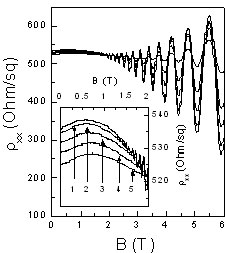 · The behavior of the magnetoresistance of the prestressed quantum well (Si1-xGex ) quantum well with hole-type charge carriers as a function of temperature and magnetic field was investigated.
The observed maxima of the magnetoresistance was used to assess findings of the various theories which describe the contribution from the interaction between the charge carriers. It turned out that the theory Sedrakyan and Raikh
most accurately describes the results of research
[5].
· The behavior of the magnetoresistance of the prestressed quantum well (Si1-xGex ) quantum well with hole-type charge carriers as a function of temperature and magnetic field was investigated.
The observed maxima of the magnetoresistance was used to assess findings of the various theories which describe the contribution from the interaction between the charge carriers. It turned out that the theory Sedrakyan and Raikh
most accurately describes the results of research
[5].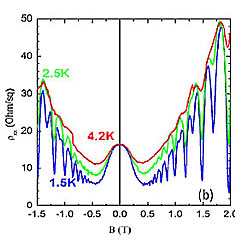 · The magnetotransport properties of the two dimensional hole gas in fully strained Ge quantum wells grown on Si0.2Ge0.8/Si(100)
substrates were studied. An extremely high hole mobility was observed, along with the lowest value of effective mass to date, using Schubnikov-de Haas oscillations for both normal and inverted structures. The channel is confirmed to be pure germanium, with low background impurity scattering that improves the hole transport [6,
7].
· The magnetotransport properties of the two dimensional hole gas in fully strained Ge quantum wells grown on Si0.2Ge0.8/Si(100)
substrates were studied. An extremely high hole mobility was observed, along with the lowest value of effective mass to date, using Schubnikov-de Haas oscillations for both normal and inverted structures. The channel is confirmed to be pure germanium, with low background impurity scattering that improves the hole transport [6,
7].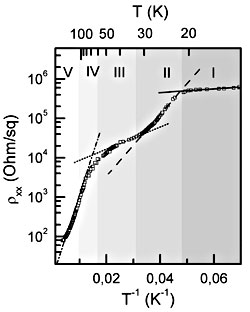 · The behaviors of resistance, magnetoresistance (up to 5 T), and Hall electromotive force (EMF) with varying temperature (10–300 K) and measuring current (10_A–10 mA) are studied for
the Si sample with CrSi2 nanocrystallites (NC) in the plane (111). The conduction in such heterostructure proceeds in the plane with the NC and is the conduction of a two-dimensional system of charge. The temperature variations of resistivity are treated in terms of the proposed model of electron hopping through the conduction band. A peculiar effect of giant reduction in resistivity with increasing the measuring current has been revealed [8, 9].
· The behaviors of resistance, magnetoresistance (up to 5 T), and Hall electromotive force (EMF) with varying temperature (10–300 K) and measuring current (10_A–10 mA) are studied for
the Si sample with CrSi2 nanocrystallites (NC) in the plane (111). The conduction in such heterostructure proceeds in the plane with the NC and is the conduction of a two-dimensional system of charge. The temperature variations of resistivity are treated in terms of the proposed model of electron hopping through the conduction band. A peculiar effect of giant reduction in resistivity with increasing the measuring current has been revealed [8, 9].
1. Berkutov
I.B. , Andrievskii V.V., Komnik Yu.F., Leadley D.R., Myronov
M., von Känel
H., Mironov
O.A. A
new method of investigating the quantum channel surface // J.Phys.:
Cond. Mat., 20,
№ 22, 224024 (2008).
2.
Berkutov I.B., Andrievskii V.V., Komnik Yu.F., Kolesnichenko Yu.A., Morris R.J.H., Leadley D.R., and Mironov O.A. Magnetotransport studies of SiGe-based p-type heterostructures: problems of the effective mass determination // Low Temp. Phys., 38, № 12, 1455-1463 (2012).
3. Berkutov I.B., Andrievskii V.V., Komnik Yu.F., Mironov O.A. and Leadley D.R. Shubnikov-de Haas oscillations of the conductivity of two-dimensional hole gas in quantum wells based on silicon and germanium. Effective mass and g-factor determination // Low Temp. Phys. 35, № 2, 188-193 (2009).
4. Berkutov I.B., Andrievskii V.V., Komnik Yu.F., Mironov O.A. Positive quasi-classical magnetoresistance and quantum effects in germanium quantum well // Low Temp. Phys. 36, № 12, 1076-1085 (2010).
5. Berkutov I.B., Andrievskii V.V., Komnik Yu.F., Hackbarth T., Leadley D.R., Mironov O.A. On the Magnetoresistance Maximum Observed in the Intermediate Magnetic Field Region for the Two-Dimensional Hole Gas in a Strained Si 0.05Ge 0.95 Quantum Well // JLTP, v. 168, № 5-6, 285-291 (2012).
6.
Mironov O.A., Hassan A.H.A., Uhlarz M., Kiatgamolchai S., Dobbie A., Morris R.J.H., Gabani S., Berkutov I.B., and Leadley D.R. New RP-CVD grown ultra-high performance selectively B-doped pure-Ge 20 nm QWs on (100)Si as basis material for post-Si CMOS technology // Physica Status Solidi (C), 11, № 1, 61–64 (2014).
7.
Mironov O.A., Hassan A.H.A.,Morris R.J.H., Dobbie A., Uhlarz M., Chrastina D.,Hague J.P., Kiatgamolchai S., Beanland R., Gabani S., Berkutov I.B., Helm M., Drachenko O., Myronov M., Leadley D.R. Ultra high hole mobilities in a pure strained Ge quantum well // Thin Solid Films, 557, 329–333 (2014)
8.
Andrievskii V. V., Komnik Yu. F., Berkutov I.B., Mirzoiev I. G., Galkin N. G., Goroshko D. L. Kinetic properties of the two-dimensional conducting system formed by CrSi2 nanocrystallites in plane (111) of silicon // Physica Status Solidi B, 251, 3, 601–608 (2014)
9.
Komnik Yu. F., Andrievskii V.V., Berkutov I.B., Mirzoiev I.G., Galkin N.G., Goroshko D.L. The 2D conducting system formed by nanocrystallites CrSi2 in the (111) plane of silicon: new object // Physica E, 64, 165–168, (2014)